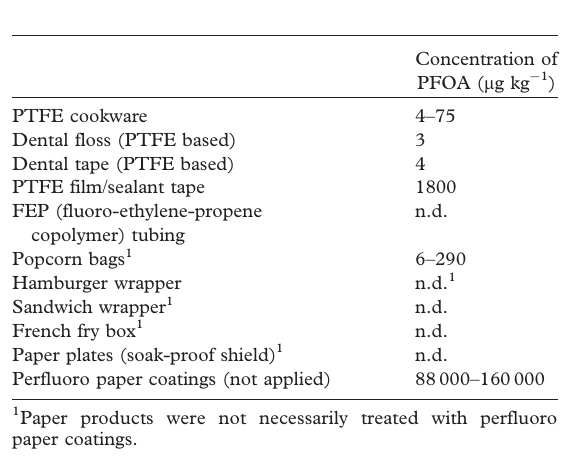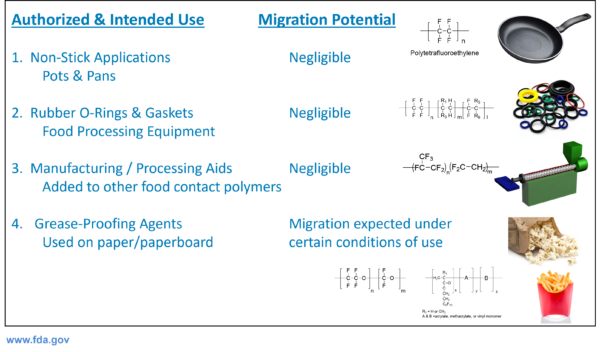PFAS in Food Contact: Applications and Regulatory Actions

The U.S. Food and Drug Administration (FDA) has studied PFAS usage in food applications, tracking its presence, migration potential, and industry phase-outs.
Per- and polyfluoroalkyl substances (PFAS) have been widely used in food contact applications due to their grease-resistant and non-stick properties. However, growing concerns about their persistence and potential health risks have led to increased regulatory scrutiny.
You can also read: PFAS Characterization and the Push for Information.
Key Studies on PFAS in Food Contact
A 2005 study served as a roadmap for the FDA to evaluate PFAS presence and quantification in food-related applications. This study detected perfluorooctanoic acid (PFOA) in several food contact materials, highlighting potential exposure risks. Although PFOA was phased out in 2011, these findings provided critical insights into PFAS usage. Follow-up studies in 2011 did not detect PFOA, though the FDA did not publicly release this data.

Summary of PFOA analysis in products in 2005. Courtesy of Perfluorochemicals: Potential sources of and migration from food packaging.
PFAS Applications in Food Contact Materials
1. PTFE Cookware
The 2005 study identified non-stick coatings in cookware, specifically polytetrafluoroethylene (PTFE), as a potential source of PFAS exposure. Although small amounts of PFOA were present in PTFE coatings, the FDA stated that its migration into food was negligible, reducing concerns about direct exposure from cookware.
2. Rubber Articles and O-Rings
PFAS-based rubber gaskets and O-rings are commonly used in food processing equipment due to their high durability. These products are made from polymerized PFAS molecules, forming high-molecular-weight resins. The FDA has indicated that these materials pose minimal risk of migration, meaning they are unlikely to transfer PFAS into food.
3. Polymer Processing Aids (PPAs)
PPAs enhance polymer processing efficiency and improve product quality. Many companies use fluoropolymer-based PPAs in polyethylene (PE) extrusion for food packaging films and profiles. These additives help manufacturers maintain smooth processing and product integrity without direct PFAS exposure risks.
4. Grease-Proofing Agents in Paper and Cardboard
PFAS-based grease-proofing agents have been widely used in paper and cardboard food packaging. However, recent studies indicate that 6:2 fluorotelomer alcohol (FTOH) bioaccumulates in animal tissues, raising concerns about immunotoxicity, reproductive toxicity, and potential carcinogenicity.
Recognizing these risks, several manufacturers voluntarily phased out PFAS-containing grease-proofing agents:
- Chemours ceased sales of these substances in June 2019.
- Daikin, AGC, and Archroma completed their phase-out by December 2023.
- 15 food contact substances (FCS) containing PFAS are no longer available in the U.S. market.

PFAS Used in Food Contact. Courtesy of FDA.
5. Fluorinated Polyethylene
In 1983, the FDA authorized polyethylene fluorination for food packaging to minimize oxygen and moisture migration, which contribute to food spoilage. However, this process can unintentionally create PFAS, a class of chemicals linked to environmental and health concerns. In January 2021, the EPA published a report suggesting that plastic fluorination likely produces PFAS. Later, the EPA confirmed PFAS contamination in HDPE containers used for mosquito control pesticides, identifying the fluorination process as the source. On August 5, 2021, the FDA reminded manufacturers that only fluorinated polyethylene produced under 21 CFR 177.1615 regulations is approved for food contact. However, some studies conducted by the FDA has proven the presence of PFAS in Fluorinated PE. Moreover, Fluorinated bottles containing PFAS can potentially contaminate PE packaging and the recycling system, raising greater concerns about their safety.
You can also read: Fluorination in Packaging and PFAS Contamination.
Importance of PFAS Detection in Food Packaging
Regulatory agencies emphasize PFAS detection in food packaging to prevent contamination and ensure safety. Total Fluorine (TF) screening helps identify potential PFAS presence, while targeted PFAS analysis provides more precise detection. These methods help assess fluorine content in packaging materials and support regulatory enforcement.
Challenges in PFAS Detection
- Total Fluorine Methods
- Identify fluorine presence but do not determine the exact PFAS compounds.
- Have limited accuracy and validation.
- Solvent Extractable Methods
- Provide targeted analysis for specific PFAS compounds.
- Are time-consuming and limited by available detection methods.
Conclusion
PFAS have played a significant role in food contact materials, but concerns over their bioaccumulation and health effects have driven regulatory action. The phase-out of PFAS-based grease-proofing agents and enhanced detection methods mark progress toward safer food packaging practices. However, continued research and improved detection technologies are essential to fully assess and regulate PFAS in food contact applications.
